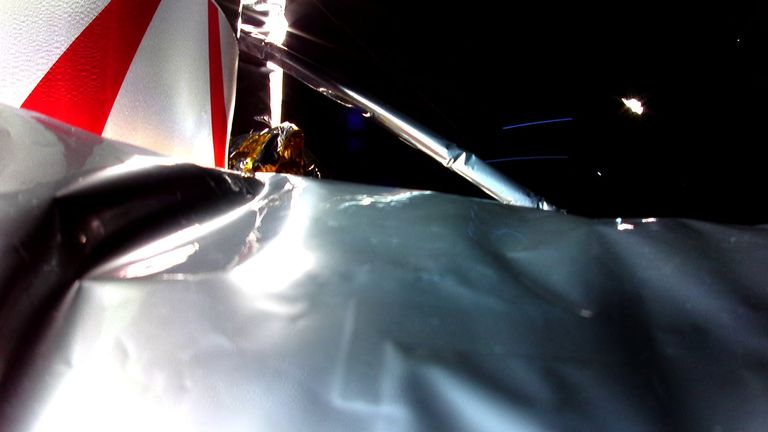A spacecraft which was heading for the moon has suffered a “critical loss of propellant”, the company behind it has said.
It appears there has been a “failure within the propulsion system”, Astrobotic added.
In the first image of the Peregrine from space, Astrobotic said Multi-Layer Insulation (MLI) was shown to be”disturbed” – the first visual clue that aligns with their data, pointing to a propulsion system anomaly.
The company said the spacecraft’s battery is now fully charged, having earlier ran low and experienced a communication “blackout”.
The team had used an “improvised manoeuvre” to point Peregrine’s “solar array” towards the sun, allowing the battery to recharge.
“We are using Peregrine’s existing power to perform as many payload and spacecraft operations as possible,” it said in its latest update on X.
NASA said: “We are working with Astrobotic to identify the root cause of the propulsion issue and evaluate how it affects NASA’s five science investigations aboard the spacecraft.
“Space is hard.”
Peregrine Mission 1 took off in Florida on a new Vulcan rocket at 7.18am UK time.
It is intended to be the first US spacecraft to land on the moon’s surface since Apollo 17 in 1972 and appeared to lift off into space as planned.
Astrobotic previously said Peregrine “successfully” separated from the rocket but an “anomaly” had occurred.
The propulsion problem threatened the “ability of the spacecraft to soft land on the moon”, it admitted.
A landing had been scheduled for 23 February.
Follow as it happened: Updates as Peregrine Mission-1 blasted off
NASA has paid Astrobotic, a space logistics start-up, $108m (£85m) for five scientific instruments to be carried to the moon – a fraction of the cost of launching its own mission.
The lander, which is the size of a garden shed, is also carrying the remains of several Star Trek cast members and the DNA of former US presidents including John F Kennedy.
Astrobotic chief executive John Thornton has previously said the craft will spend 12 days in transit between the Earth and lunar orbit but the bulk of the time will be waiting, circling the moon for the “local lighting conditions” of the team’s landing site to be correct.
In its first update on the issue on X, Astrobotic said on Monday that after successfully separating from United Launch Alliance’s Vulcan rocket, the Peregrine lander began receiving telemetry via NASA.
“After successful propulsion systems activation, Peregrine entered a safe operational state,” it went on.
“Unfortunately, an anomaly then occurred, which prevented Astrobotic from achieving a stable sun-pointing orientation.”
Part of the reason for the renewal of interest in lunar missions is the discovery of water on the moon, which could hydrate astronauts and be a source of oxygen and fuel – saving future missions from having to store their own supplies.
It is hoped the moon could provide a staging post for missions to Mars or even beyond.
Controversy over human remains
The Peregrine mission has attracted controversy because of some of its commercial payloads.
Among the remains on board are those of Star Trek creator Gene Roddenbury – along with his wife and son – as well as icons from the show Nichelle Nichols, James Doohan and DeForest Kelley, who played Nyota Uhura, Montgomery Scott and Dr Leonard McCoy.
The DNA of former US presidents George Washington, Dwight Eisenhower and John F Kennedy are also being transported.
The Navajo Nation of Native Americans had written to NASA demanding the launch should be delayed because there will be capsules on board containing human remains.
The nation’s president, Buu Nygren, said sending cremated remains to the moon “is tantamount to the desecration of this sacred space”.
Eyebrows have also been raised over other commercial payloads.
The delivery company DHL is launching its MoonBox programme, taking mementoes such as photos, novels and even a sample of Mount Everest to the lunar surface.
Astrobotic has shrugged off criticism of the mission’s commercial cargo.
“To be leading America back to the surface of the moon is a momentous honour,” said Mr Thornton.
